Do you know WHAT brought users to your website today?
What specific goals or tasks are they trying to accomplish on your website?
With the right website feedback tool, you can dive deep into your customers’ intentions, understand their needs, and provide a superior online experience tailored to their goals and interests.
Here’s the deal: If your website isn’t user-friendly, 88% of online shoppers won’t come back. So, it’s crucial to focus on making their experience great. Research even shows that for every dollar you spend on this, you get $100 in return.
And the key to it is
— Website Feedback.
A website feedback tool simplifies the process for you, making it easy to enhance your website, meet customer expectations, and offer a seamless journey for users. This way you can improve your user’s experience, offer them a seamless and efficient journey during their visit, and enhance your website to meet customer expectations.
Not just that.
There is a lot more to uncover about website feedback. This guide is going to tell you everything from the importance of website feedback to benefits, how to do it effectively, and how to ask for website feedback.
What is Website Feedback?
Website feedback is the information and insights gathered from website users. It helps you to understand what users like and dislike, and where they encounter problems. This feedback can be collected through on-page surveys, user testing, forms, analytics, and monitoring social media.
By gathering and analyzing this feedback, you can make improvements to create a better customer experience and meet their website’s goals. Also, you can club this data with web analytics to enhance your user experience, increase traffic, and drive business.
But why is it crucial?
Why is Website Feedback Important?
Website feedback is crucial for understanding the WHY behind user actions, complementing the insights provided by analytics tools like Heatmaps, Session Recordings, and Google Analytics. While analytics reveal user actions, they often fall short of explaining the reasons behind those actions.
For example, you notice a significant drop-off on an order page. So you run the analytics and it tells you that 70% of users leave before completing the order form. But it’s insufficient because it can’t clarify the reason why there’s a drop. This is where website feedback comes in. It plays a vital role as they gather qualitative insights directly from users, shedding light on their suggestions, concerns, and pain points, such as high shipping costs deterring them.
Also, when users regularly interact with your website they won’t respond to you by email or SMS. Asking for their feedback on the website is the key to engaging with this segment. Not only are they already present, but they will share in-moment feedback with you.
This brings us to the next section – the advantages of collecting website feedback.
Benefits of Collecting Website Feedback
Here are the key benefits of gathering website feedback that empower you to enhance your online presence:
- Enhances User Experience: 86% of customers are willing to pay more for a superior customer experience. Collecting feedback helps identify and address usability issues, leading to a smoother, more satisfying user experience and increased customer retention.
- Improves Website Functionality: 50% of consumers consider a company’s website crucial for their overall brand’s success. That’s why you should conduct user feedback because it often reveals technical issues analytics miss. By addressing these issues promptly, you can ensure your website operates smoothly and efficiently.
- Boosts Conversions: By listening to the voice of your customers via feedback and making the necessary improvements, you can increase conversion rates, translating into more sales, sign-ups, and other desired actions that directly benefit your business.
- Gains a Competitive Edge: 85% of issues can be solved by testing five users. Websites that actively collect and act on user feedback gain a competitive advantage. Continuous improvement based on user preferences allows you to outperform competitors and attract more users.
- Drives Data-Driven Decisions: Feedback provides valuable insights that guide website design and content decisions, ensuring your changes align with user preferences for more effective improvements.
- Improves Response Rate: Ask users for feedback right where they are instead of sending surveys through SMS, WhatsApp, or email. This boosts response rates by making the process immediate and seamless within their current platform.
- Builds Customer Loyalty: 96% of customers believe customer service is essential for brand loyalty. When you listen and respond to user feedback, it shows you care about their needs. This helps you in building trust and long-lasting customer relationships ultimately leading to increased customer loyalty.
After knowing the benefits of collecting website feedback, let’s move ahead and understand what website feedback surveys are and their types.
What is a Website Feedback Survey?
A website feedback survey is a structured method employed by businesses to gather feedback and opinions from users regarding their experience on a website. This invaluable tool aids companies in making improvements and better catering to users’ needs.
Let’s say you’re browsing your favorite store’s website online. After a few minutes, a pop-up survey came asking the following questions:
- Was it easy to find the product you want? – This helps the website owner to understand the website’s navigation and search functions.
- Did you face any issues with the website? – This question seeks to uncover any technical problems or usability issues you (customer) may have encountered.
- How likely are you to make a purchase? – Here, they’re interested in your likelihood to complete a transaction, which is a critical measure of their website’s effectiveness.
- Could you please share any suggestions to make our website better? – They’re inviting your ideas for improvement.
With these questions, they want to know how well their website is completing and exceeding your needs. Also, there are different types of website feedback that you can conduct to improve your website.
Launch your Website Feedback Survey!
6 Types of Website Feedback Form
There are 6 different types of website feedback that you can conduct to gather unique insights and data from users or visitors:
1. Qualitative Feedback
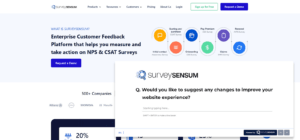 This type of feedback gathers the WHY behind user actions. It provides in-depth insights into the user experience through open-ended questions where users can give descriptive comments and suggestions. Also, it helps website owners understand the specific issues, concerns, and preferences of users.
This type of feedback gathers the WHY behind user actions. It provides in-depth insights into the user experience through open-ended questions where users can give descriptive comments and suggestions. Also, it helps website owners understand the specific issues, concerns, and preferences of users.
For example, you can ask a question – ‘Would you like to suggest any changes to improve your website experience?’
The users can give you qualitative feedback stating, “I found it hard to navigate the site because the menu was confusing.” This kind of feedback is invaluable for making targeted improvements and enhancing the user experience.
2. Quantitative Feedback
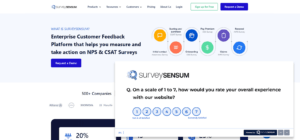
Quantitative feedback relies on numerical data and metrics to evaluate website performance. It involves analyzing numbers to assess the overall success and effectiveness of a website.
Examples of quantitative feedback include metrics like bounce rates, click-through rates, conversion rates, and page load times. This type of feedback is essential for tracking trends, identifying patterns, and measuring the impact of changes made to the website.
For instance, a high bounce rate might indicate that users are not finding what they need on a particular page, prompting further investigation and improvement.
3. Explicit Feedback
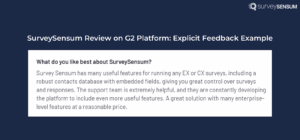
Explicit feedback is the feedback that users provide directly and intentionally. Users express their opinions and preferences openly through surveys, reviews, ratings, or written comments. It is often collected through feedback forms, online surveys, and review platforms. Explicit feedback is valuable for understanding user satisfaction, preferences, and specific issues they want to highlight.
For example, a user might rate a product with 5 stars and leave a comment praising its quality in an online review. This type of feedback is explicit because the user intentionally shared their opinion.
4. Implicit Feedback
Implicit feedback is gathered from user behavior and actions on the website, often without the user consciously intending to provide feedback. It includes tracking user interactions such as clicks, scroll depth, time spent on pages, and mouse movements. Implicit feedback is analyzed to understand user satisfaction, content engagement, and website usability.
For instance, if users frequently click on a particular product image and spend more time on a specific page, it can imply strong user interest in that product. Website owners can use this data to optimize content and layout for better user engagement.
5. Direct Feedback
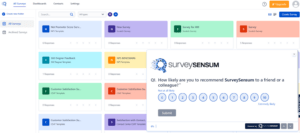
Direct feedback is collected through channels that enable users to communicate their thoughts and concerns directly to website owners. These channels include contact forms, chat support, and dedicated feedback buttons. Users can reach out with questions, comments, or issues, making it a straightforward way to provide feedback. This offers the advantage of real-time communication and the ability to address specific user inquiries promptly.
For instance, a user might use the contact form to report a technical issue on the website, enabling the website owner to respond and resolve the problem directly.
6. Indirect Feedback
Indirect feedback is gathered from sources other than direct user communication. It includes monitoring social media mentions, and external reviews on platforms like Yelp or Google, and observing user interactions with your website’s content and features. Indirect feedback offers insights into user sentiment, reputation, and behavior that may not be evident from on-site data alone.
For example, monitoring social media conversations about your brand or product can reveal user opinions and sentiments, even if they haven’t directly contacted your website. This type of feedback provides a broader perspective on how users perceive your brand or website.
You can incorporate any one of these types of website feedback to have a comprehensive view of the user experience. With this, you can make informed decisions for website improvement and optimization.
Create Website Feedback Forms on SurveySensum for Free!
How to Capture Website Feedback?
Capturing website feedback involves various strategies and tools to collect user insights and opinions effectively. Here are the following ways you can use to capture the website feedback:
- On-Page Surveys: Embed on-page surveys within specific pages when you want to collect feedback during or immediately after user interaction, such as the checkout process or product selection.
- Side Tab Surveys: Implement these side tab surveys on your website to gather seamless customer feedback. This provides an unobtrusive option for users to share thoughts on the side of the screen.
- Slide Up & Bottom Bar Surveys: Use these surveys to gather feedback on the overall user experience as they elegantly slide into view or appear at the bottom of the screen without causing disruption.
- Pop-Up Surveys: Employ pop-up surveys to capture feedback following specific user actions or events, such as a completed purchase or newsletter sign-up. They help understand user intent and evaluate the success of critical website processes.
- Feedback Button Survey: Displayed as a button or tab on your website, these surveys invite users to provide feedback. They are versatile and serve well for general feedback, positioned on every page, offering users the ability to share their thoughts at any moment.
- Exit Intent Survey: Implement exit-intent surveys to uncover why users are exiting your website and identify specific issues driving them away, offering insights into abandonment reasons and areas for potential improvement.
- Usability Testing: Engage in usability testing when assessing the effectiveness and ease of use of your website’s design, features, or functionality. It involves direct observation of users as they navigate your website and complete specific tasks, providing real-time feedback to identify usability issues.
That’s how you gather website feedback effectively. By strategically selecting the appropriate survey method for specific touchpoints across the customer journey, you can effectively gain actionable insights, and continuously enhance the user experience on your website.
But wait.
There are more channels through which you should gather feedback before taking any action:
- Social Media: Keep an eye on platforms like Instagram, Facebook, Twitter, etc. where users openly share their thoughts about your website. This real-time feedback can help you stay engaged with your online community.
- Community Forums and Discussion Groups: Participate in forums and groups related to your website. Users often discuss their experiences and concerns here, providing valuable insights.
- Product Reviews: Check out reviews on platforms like G2, Capterra, Yelp and Google. They offer detailed feedback on specific features, helping you identify what users like and dislike about your website.
Now that you know how to capture the website feedback from multiple channels to gain a comprehensive understanding of your website’s user experience. It’s time to know which customer feedback form you should conduct and when.
Types of Website Feedback Forms
There are 6 types of customer feedback forms with which you can capture user opinions and improve your website’s performance:
1. NPS Form
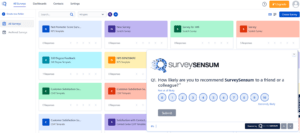
You should use NPS surveys to gauge user loyalty and identify potential brand advocates, providing insights into overall satisfaction. It is useful for companies like SaaS, digital newspapers, etc. Conduct these surveys once in three months to track changes in user loyalty and identify trends over time, typically after purchases or interactions.
2. CSAT Form
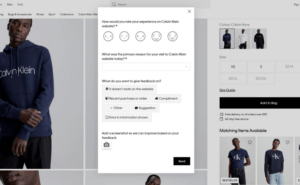
Deploy CSAT surveys to measure satisfaction with specific interactions or experiences, helping pinpoint areas for improvement. Run these surveys immediately after user interactions, such as after a customer support chat or a successful purchase.
3. CES Form
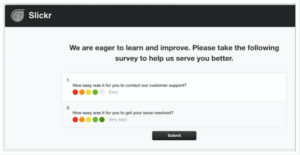
Implement CES surveys to evaluate the ease of using your website’s features and services. For example, you can enhance your e-commerce website’s user experience by launching this survey and, inquiring about the ease of making a purchase. Conduct CES surveys after onboarding to assess the ease of use.
4. Product Feedback Form
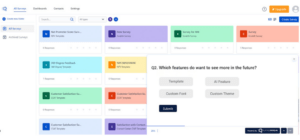
Utilize product feedback forms to gather user insights to enhance your product or services, understanding what users like and dislike about your offerings. Run these surveys when you launch a new product or feature to know customers’ experiences and expectations.
5. ‘Was it Helpful’ Form

Employ ‘Was it Helpful’ forms to assess content usefulness and identify areas that need improvement, gauging the relevance and quality of your content. Place these forms on content pages, such as articles or FAQs, to allow users to provide immediate feedback.
6. Subscription Cancellation
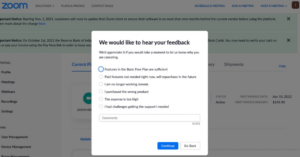
Implement subscription cancellation feedback forms to gather insights when users cancel subscriptions, revealing valuable information for retention and service enhancement, and understanding why customers are churning. Utilize these forms when users initiate the subscription cancellation process to capture insights from users who have decided to leave.
Conducting these feedback forms at the right moments ensures that you collect timely and relevant insights, enabling data-driven decisions for improving your website’s user experience.
Launch Your Customer Feedback Forms Today!
Use Analytical Tools to Strategize Feedback Opportunities
Analytics tools provide invaluable real-time insights into your website’s performance. Leveraging this information is a powerful strategy to solicit feedback from customers effectively. Here’s how to make the most of your analytics data:
- Analyze Website Performance: Start by examining your website’s performance data. Identify winning pages, top-performing posts, and pages with the highest conversion rates. This analysis helps you pinpoint the areas where customers are most engaged and satisfied.
- Strategically Place Feedback Surveys: Based on the insights gained, strategically position feedback surveys, cards, and popups on specific pages. This targeted approach ensures that you collect feedback from users who are interacting with your website’s strengths.
→ For example, add surveys on your product page if the insights show that users like your product page.
- Feedback on Top-Performing Pages: Utilize feedback forms on your top-performing pages to understand what drives customers to them. This information can be valuable for maintaining and enhancing the aspects that draw the most user attention.
- Collect Feedback on Less Popular Pages: Don’t overlook less popular pages. Use feedback surveys on these pages to understand the issues that may be contributing to high bounce rates and low conversion rates. This insight helps you address pain points and improve these pages.
- Data Comparison for Optimization: Regularly compare the data from feedback surveys with your analytics. This process allows you to make data-driven decisions for optimizing web pages and, consequently, enhancing the overall user experience on your website.
Pro tip: To further refine your approach, consider combining analytics data with session tools and customer journey tools. By doing so, you can plan the specific types of customer feedback you need to collect from different web pages, creating a more targeted and informed feedback strategy.
By harnessing the power of analytics tools to guide your feedback collection efforts, you can enhance the user experience on your website, improve customer satisfaction, and ultimately drive better results.
How to Analyze Website Feedback?
Analyzing website feedback is a crucial step in turning user opinions and suggestions into actionable insights. Here’s a systematic approach to help you make the most of the feedback you collect:
- Gather and Centralize Feedback: Begin by collecting feedback from various sources, including surveys, feedback forms, social media, and customer support channels. Centralize this data into a dedicated platform or system for easier analysis.
- Categorize Feedback: Organize the feedback into categories or themes. Common categories may include usability issues, content quality, technical problems, and feature requests. Categorization simplifies the analysis process.
- Prioritize Feedback: Not all feedback is of equal importance. Prioritize feedback based on factors like the frequency of mentions, the severity of issues, and alignment with your website’s goals.
- Identify Trends: Look for recurring trends or patterns in the feedback. Identifying common issues or consistent user preferences helps you focus your efforts on areas that matter most to your users.
- Quantitative vs. Qualitative Analysis: Feedback can be both quantitative (rating scales like Likert, multiple-choice questions) and qualitative (open-ended comments). Analyze quantitative data for statistical insights, and delve into qualitative responses for in-depth user narratives and context.
- Segmentation: Analyze feedback by customer segmentation. Consider factors like user demographics, behavior, or the source of the feedback. This can reveal variations in user opinions and needs.
- Sentiment Analysis: Employ sentiment analysis tools to gauge the emotional tone of feedback. Understanding the sentiment behind the comments can provide insights into user satisfaction and areas of concern.
- Feedback Metrics: Use key feedback metrics like NPS, CSAT, or CES to measure overall satisfaction and loyalty.
- Data Visualization: Present your findings visually using charts, graphs, and dashboards. Visualization makes it easier to communicate feedback insights to stakeholders.
- Root Cause Analysis: For issues identified in feedback, perform a root cause analysis to understand the underlying reasons. This involves digging deeper to discover why certain problems exist.
- Actionable Insights: Finally, turn the analysis into actionable insights. Create a plan for addressing the issues, making improvements, and enhancing the user experience. Ensure that feedback leads to concrete changes on your website.
- Continuous Improvement: Feedback analysis should be an ongoing process. Regularly review and adjust your analysis techniques to stay aligned with evolving user needs and website goals.
By following these steps, you can effectively analyze website feedback and use it to drive improvements that enhance user satisfaction and overall website performance.
Enhance User Satisfaction with Website Feedback!
Best Practices for Collecting and Using Website Feedback
Effective website feedback collection and utilization are paramount for enhancing user experiences and achieving business success. Here are the best practices that will help you navigate this process with finesse and achieve the desired results:
- Diversify Collection Methods: Employ various feedback collection methods, including surveys, feedback widgets, on-page surveys, and social media listening. Diversification ensures you capture insights from different touchpoints and user preferences.
- Keep Surveys Concise: Design surveys to be concise and focused. Avoid overwhelming users with lengthy questionnaires. A brief, targeted survey is more likely to yield valuable responses.
- Target Specific User Segments: Tailor feedback collection to specific user segments. For instance, create separate surveys for new visitors and returning customers to gather insights relevant to their interactions.
- Strategically Time Surveys: Choose optimal moments to display surveys. Avoid interrupting critical user tasks and opt for timing that complements the user journey, such as after a successful transaction.
- Analyze Feedback Continuously: Establish a routine for analyzing feedback data. Regular analysis allows you to identify trends, prioritize improvements, and ensure a responsive user experience.
- Respond to Feedback: Show users that their feedback is valued by promptly responding to their concerns. Addressing issues and sharing updates on implemented improvements fosters trust and loyalty.
- Use Feedback for Website Optimization: Translate feedback into actionable changes on your website. Whether it’s fixing usability issues or enhancing content, ensure feedback guides your optimization efforts.
- Monitor User Behavior: Complement feedback data with insights from user behavior analytics tools. This combined approach offers a comprehensive view of the user experience and helps you make informed decisions.
- Leverage Customer Support Channels: Utilize customer support interactions as feedback opportunities. Engage with users through chat, email, or phone calls, and gather insights that might not be captured through traditional surveys.
- Conduct A/B Testing: Implement A/B testing to validate the impact of changes inspired by user feedback. This method allows you to make data-driven decisions and assess the effectiveness of optimizations.
- Measure User Satisfaction: Use metrics like Net Promoter Score, Customer Satisfaction, and Customer Effort Score to quantify user satisfaction and track it over time.
- Implement Feedback Loops: Close the feedback loop by informing users about the changes you’ve made based on their feedback. This practice builds transparency and encourages continued participation.
- Prioritize User-Centered Design: Embrace a user-centered design approach that values user input in all aspects of website development. This approach ensures that the user experience remains a primary focus.
By following these best practices, you can collect and utilize website feedback effectively to enhance your website, improve user satisfaction, and drive better results for your business.
Conclusion
88% of online consumers are less likely to return to a website after a bad experience. This statistic highlights the importance of conducting website feedback. This practice allows you to understand and cater to evolving user needs, boosting satisfaction, conversions, and loyalty.
Continuous feedback keeps your website competitive, helping you address emerging issues and stay in tune with industry trends, creating a user-centric, responsive platform for sustained success in the digital realm. As you embark on your journey of continuous website feedback collection, consider the valuable support of tools like SurveySensum. It offers a comprehensive platform for efficiently gathering, analyzing, and acting upon user feedback.
With user-friendly features and robust analytics, it empowers you to make data-driven decisions and enhance the user experience, ensuring your website remains a beacon of user-centric excellence in the digital landscape.







